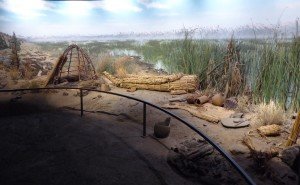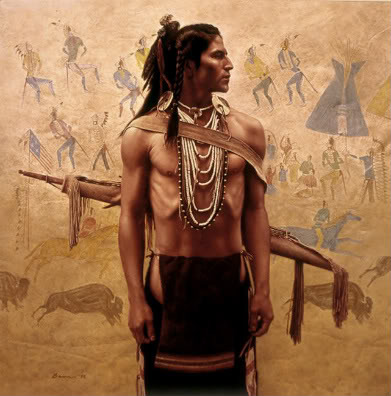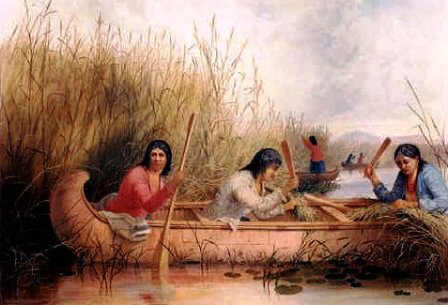Indians 101: Pine Nuts
For thousands of years Indian people have lived and prospered in the Great Basin by exploiting the natural resources of the area. For Indian people in the Great Basin-the Shoshone, Paiute, Washo, and Ute-one of the important traditional resources of the region was the piñon pine whose nuts provided them with nutrition.
The Great Basin:
The Great Basin includes the high desert regions between the Sierra Nevada and the Rocky Mountains. It is bounded on the north by the Columbia Plateau and on the south by the Colorado Plateau. It includes southern Oregon and Idaho, a small portion of southwestern Montana, western Wyoming, eastern California, all of Nevada and Utah, a portion of northern Arizona, and most of western Colorado. This is an area which is characterized by low rainfall and extremes of temperature. The valleys in the area are 3,000 to 6,000 feet in altitude and are separated by mountain ranges running north and south that are 8,000 to 12,000 feet in elevation. The rivers in this region do not flow into the ocean, but simply disappear into the sand.

The Great Basin is an ecologically sparse environment which includes by small areas where water, game, and plant life are abundant. The summers are often hot and the winters cold. This is an area which seems inhospitable to human habitation, yet Indian people have lived here for thousands of years. For Indian people to live in the Great Basin, they had to have a rather intimate knowledge of a fairly large territory of several hundred square miles: a territory would often encompass the full range of desert biomes.
Traditional Subsistence:
Much of the subsistence of the Great Basin Indian tribes depended on the gathering of wild plants. It is estimated that 30 to 70% of the Great Basin diet was based on plants. Several major groups of plants were important to the subsistence of the Great Basin peoples. These include piñon nuts, mesquite, acorns, agave, camas, sego lily, tobacco root, yampa, biscuitroot, bitterroot, cattails, and berries (wolfberry, buckberry, chokecherries). In general, the gathering year was divided into four periods:
Early Spring: at this time the stored foods were running low and the people were facing some hunger. The first edible plants would appear along streams, near lakes, and in the low hills where the snow first disappeared.
Early Summer: at this time a number of plants would begin to ripen, particularly in the moist hills, but some in the desert valleys. To gather these plants the people would have to leave their winter villages. As the seeds would begin to ripen in the mountains, they would then move into these areas.
Late Summer: at this time the edible roots would mature. These plants could be dug at leisure.
Late Fall: at this time the pine nuts would ripen. However, pine nuts tend to be erratic as each tree yields only once in 3-4 years: in some years there are virtually none in some areas while they are abundant in other places. The harvest period for pine nuts can be 2-3 weeks in some areas and only 10 days in others.
Traditional Use of Piñon Nuts:
Among the Western Shoshone of Nevada, piñon nuts were the staple winter food. Pine nuts are high in fat and this means that less meat would be required in the diet. Pine nuts have about 3,000 calories per pound, which means that they not for the calorie-conscious. Piñon nuts are also high in carbohydrates and protein.
The pine nuts are gathered in September and October. The cones require two years to mature, so careful observation of the cones means that the scarcity or abundance of the crop can be predicted a year in advance.
One of the common ways of collecting the pine nuts was to collect the cones just before they were about to break open. Using poles, the men would beat the trees to get the cones to drop. Then, using a stone hammer or a stick, the cones would be broken open to collect the seeds. Another way of collecting the pine nuts was to pick the seeds from the forest floor after the cones had dried and opened on the tree. This was, however, both labor intensive and time consuming.
Once the seeds were removed from the cones, the seeds were parched on a basketry tray with coals, winnowed, and then either stored in woven sacks or pits, or ground into a flour from which bread or soup could be made.
Prior to European contact, a typical Shoshone family could gather about 1,200 pounds of pine nuts in the fall and this would last the family for about four months. Most frequently the pine nuts were ground with a metate and mano. The resulting meal was then mixed with cold water and stirred. Most frequently the mush was eaten cold. Among some of the tribes the pine nut mush was boiled by placing hot stones in a basket container with the mush until it boiled. In the winter, some of the tribes also made a cold treat out of the mush by setting it outside to freeze.
In some parts of the Great Basin, such as the Steptoe Valley, enough pine nuts to last for two years could be gathered during a good year. In order to preserve the nuts, they were roasted and then buried in a cold place in the mountains.
Among the Owens Valley Paiute, the pine nut gathering areas were divided into family plots. If a family were to trespass on pine-nut areas claimed by another family, violence would ensue. This was especially true if the families were from different bands.
Among some groups, such as the Shoshone of the Ione and Reese River Valleys, the pine nut tracts were owned by the villages. The tracts were in the mountains behind the villages and were bounded by natural boundaries known to everyone.
Piñon Nuts Today:
The Indian people of the Great Basin still gather piñon nuts. Today the gathering of the piñon nuts is an affirmation of their cultural heritage rather than for their physical survival. The nuts are still used in traditional foods and some are sold to supplement the family income. In Nevada, their right to gather the piñon nuts is protected by both state law and by treaty rights.



